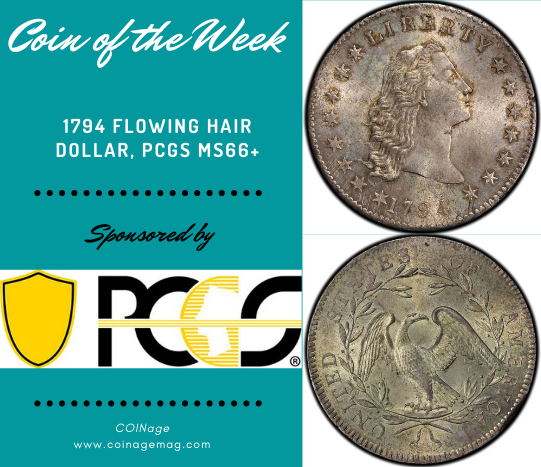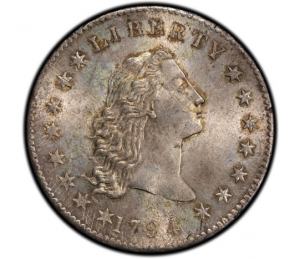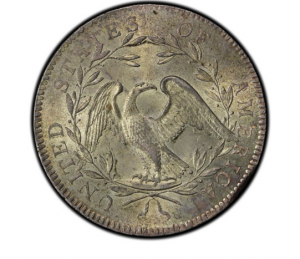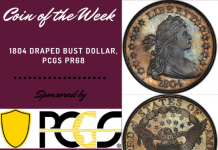
The 1794 Flowing Hair dollar is the Professional Coin Grading Services (PCGS) Coin of the Week.
The United States silver dollar is one of the most widely popular coins, and the very first of these iconic collectibles is the 1794 Flowing Hair dollar. Struck just two years after the United States Mint was established in 1792 and a year after the first mass-circulating copper coins were produced in 1793, the 1794 Flowing Hair dollar represents the first in a long line of silver dollars produced for circulation in the United States Mint.
About the Flowing Hair Dollar
The 1794 Flowing Hair dollar is part of the larger body of early American dollars, which spans from 1794 through 1804. The Flowing Hair dollar-type only saw two years of production and was replaced in late 1795 by the Draped Bust dollar, along with which the Flowing Hair is usually collected. All early American dollars are considered scarce, making them a challenge for collectors whether they seek only one example for a type set or each date and variety for a more comprehensive collection. The 1794 Flowing Hair dollar is sought after not just by type collectors but also by many numismatists given its history as an early American rarity and serving as the first year of the silver dollar.
Only 1,758 examples of the 1794 Flowing Hair dollar were released, making this coin rare from the onset. Most examples saw extensive circulation, and the vast majority of the 150 or so survivors exhibit heavy wear. However, a handful of uncirculated specimens survive. One of the finest known is graded MS66+ by Professional Coin Grading Service and once resided in the prestigious cabinets of Lord St. Oswald, Jimmy Hayes, D. Brent Pogue, and Bob R. Simpson. In August 2021, it sold for a whopping $6,600,000 to become the highest price ever paid for a Mint State example of the 1794 Flowing Hair dollar.
Coin Grading
Grade refers to a coin’s level of preservation: how many nicks or scratches or other imperfections it has. Coins are graded on a scale of one to 70, with higher numbers signifying higher grades. One represents a coin that is so well worn that it’s barely identifiable as to its type. 70 represents a perfect coin: a coin that when viewed under a five-power magnifying glass has no visible imperfections.
60 through 70 represent the Mint State (MS) grades. A coin graded MS-60 can have so many nicks and scratches and flaws that it might look as if Godzilla used it as a teething ring. MS-65 is the industry standard for “Gem.” MS-66 through MS-69 are the near-flawless super-grade or wonder coin assignations. With each grade level above MS-66, the value might double or triple.
Grade names are used in addition to numerical grades. In ascending order, these word grades are About or Almost Good; Good; Very Good; Fine; Very Fine; Extra or Extremely Fine; About or Almost Uncirculated; and Mint State.
*Images courtesy of Heritage Auctions.

















